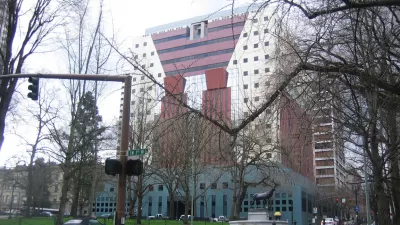A renovation saved the Portland Building, designed by postmodern pioneer Michael Graves, from demolition, but its likely doomed its status on the National Register of Historic Places.

"An audit by the City of Portland, Oregon, has found that the DLR Group’s renovation of the Michael Graves–designed Portland Building is over budget and, once complete, will cause the building to lose its historic landmark status," reports Jonathan Hilburg.
The Portland Building came close to being demolished back in 2014, due to "desperately needed waterproofing, seismic, and efficiency upgrades."
The city an alternative that involved reskinning the tower "with a unitized aluminum rainscreen designed to imitate the original facade."
"However, according to the City of Portland’s audit of the renovation, a follow-up to an initial risk analysis report, the budget has increased to $214 million. It was also revealed that once the project is complete, the building will be removed from the National Register of Historic Places," according to Hilburg.
FULL STORY: DLR Group’s Portland Building renovation will kill its historic status

Planetizen Federal Action Tracker
A weekly monitor of how Trump’s orders and actions are impacting planners and planning in America.

Maui's Vacation Rental Debate Turns Ugly
Verbal attacks, misinformation campaigns and fistfights plague a high-stakes debate to convert thousands of vacation rentals into long-term housing.

San Francisco Suspends Traffic Calming Amidst Record Deaths
Citing “a challenging fiscal landscape,” the city will cease the program on the heels of 42 traffic deaths, including 24 pedestrians.

Amtrak Rolls Out New Orleans to Alabama “Mardi Gras” Train
The new service will operate morning and evening departures between Mobile and New Orleans.

The Subversive Car-Free Guide to Trump's Great American Road Trip
Car-free ways to access Chicagoland’s best tourist attractions.

San Antonio and Austin are Fusing Into one Massive Megaregion
The region spanning the two central Texas cities is growing fast, posing challenges for local infrastructure and water supplies.
Urban Design for Planners 1: Software Tools
This six-course series explores essential urban design concepts using open source software and equips planners with the tools they need to participate fully in the urban design process.
Planning for Universal Design
Learn the tools for implementing Universal Design in planning regulations.
Heyer Gruel & Associates PA
JM Goldson LLC
Custer County Colorado
City of Camden Redevelopment Agency
City of Astoria
Transportation Research & Education Center (TREC) at Portland State University
Jefferson Parish Government
Camden Redevelopment Agency
City of Claremont




























